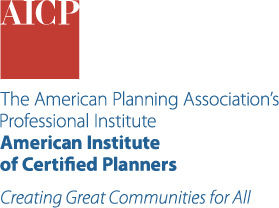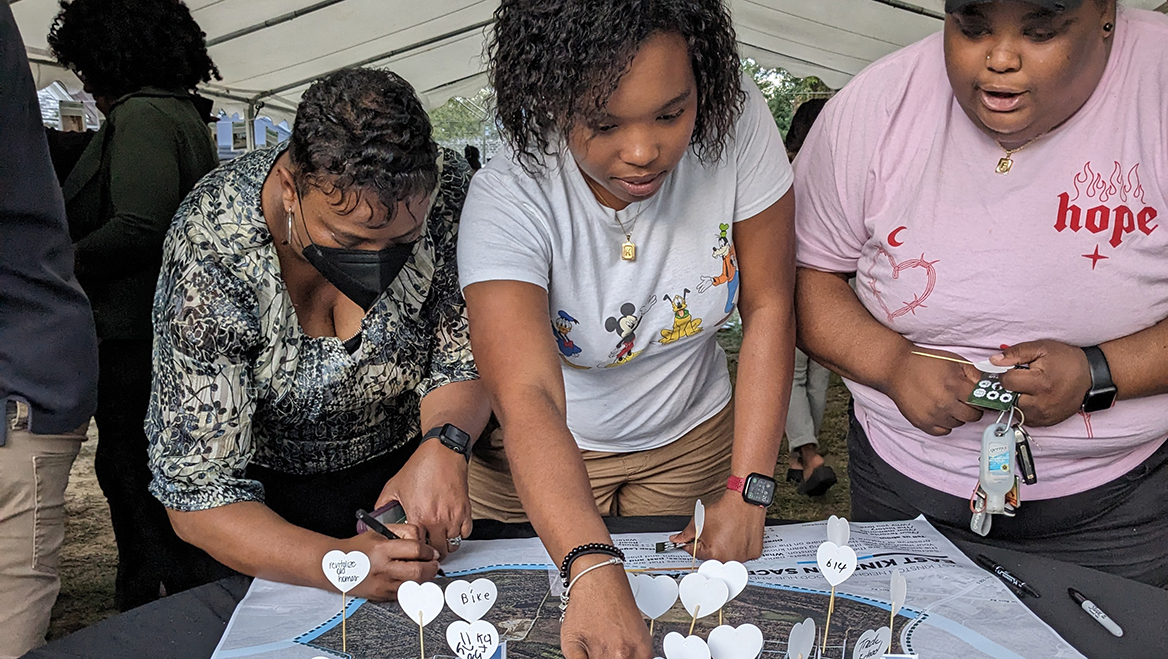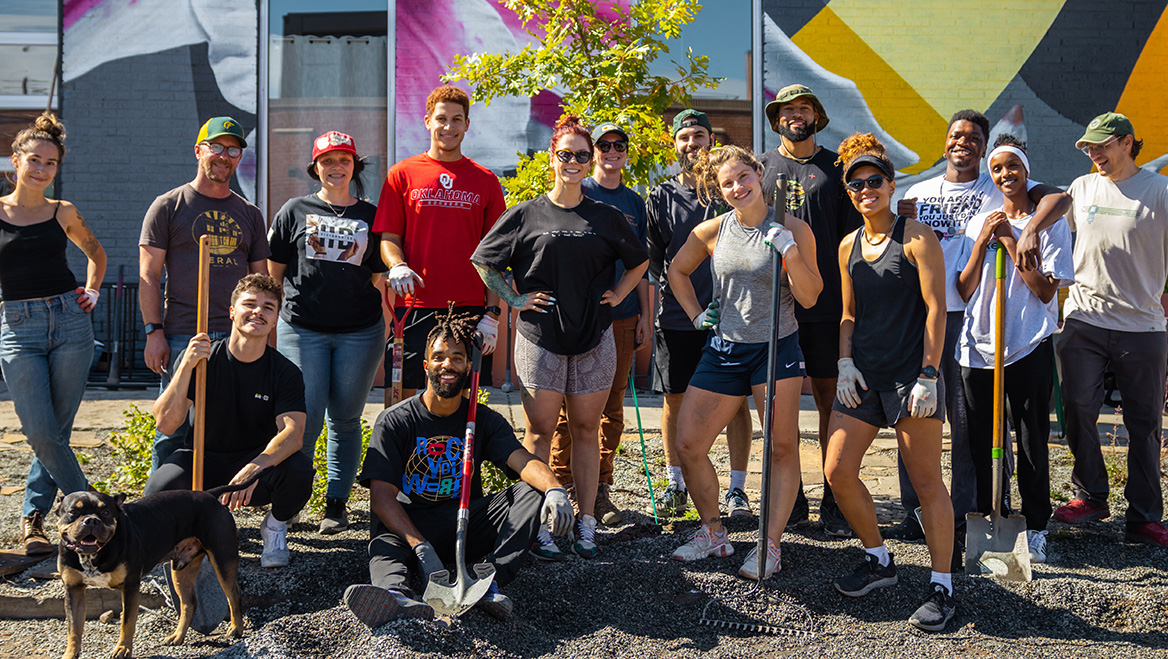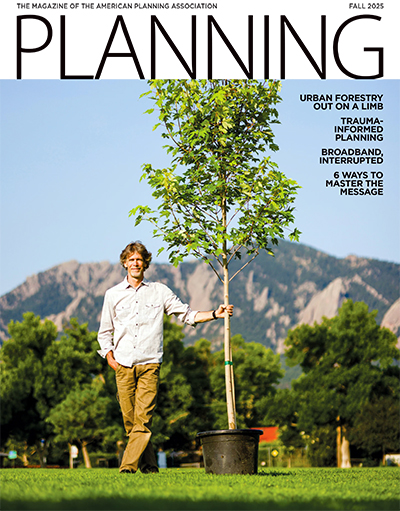Aug. 21, 2025
Kinston, a close-knit community of 20,000 in eastern North Carolina, was once nicknamed the tobacco capital of the world before de-industrialization in the 1970s led to job losses and empty warehouses. More recently, the aftereffects of five hurricanes over the past 25 years left the community feeling "blow after blow," says Chris Suggs, a lifelong resident.
In response, Suggs founded Kinston Teens in 2014, when he was just 14 years old, to help give a voice to young people in the community who were suffering from the impact of gun violence, gang activity, and neighborhood disinvestment. It came during a period of time when there were as many as 61 shootings in a year, and some of his friends and classmates were victims.
It was his hope that Kinston Teens could position those affected by traumatic events in the community to help design, develop, and implement solutions by getting members engaged in local planning projects. They started in 2014 by working with city staffers on a downtown street revitalization plan.
However, when the group decided to celebrate its 10th anniversary by designing and developing a more responsive piece of civic infrastructure, Suggs decided to call on another collaborator: Design Workshop. The landscape architecture and planning firm had created a new master plan for Emma Webb Park in Kinston in 2021, working with Kinston Teens to facilitate community engagement.
Kinston Teens and Design Workshop imagined the new project, the East Kinston Neighborhood Hub, as a social service and community center that would incorporate multi-use spaces, a commercial kitchen to support local entrepreneurs, gardens, and play spaces. It would also be designed to function as a disaster hub during future flooding incidents.
"We had a great rapport with them," Suggs says of working with planning professionals and architects on the Design Workshop team, who treated community members not as clients but as co-leaders.
"Trauma-informed planning explicitly considers how can we build an environment and use a process to best support their wellbeing, including health and human services, and child welfare. What does that neighborhood block look like?"— Krista Schroeder, author of PAS QuickNotes 103, on trauma-informed planning
The way the community's past was woven into the Kinston project's new vision of social infrastructure is an example of trauma-informed planning. The roots of this approach come from health care and human services to help those who have experienced highly stressful experiences by focusing on six key principles: safety; trustworthiness and transparency; peer support; collaboration and mutuality; empowerment, voice, and choice; and attention to cultural, historical, and gender issues. When applied to community development, planners can factor in the multi-generational trauma of a place and rely more on collaborations with community groups to try to mitigate potential future harm and foster resilience.
Krista Schroeder, a researcher and professor at Temple University and author of PAS QuickNotes 103, which is about trauma-informed planning, has studied the health impacts of trauma. She found that much of the research and literature was focused on the individual, not the built environment.
"Trauma-informed planning builds on what's normally done," says Schroeder. "It explicitly considers how we can build an environment and use a process to best support their wellbeing, including health and human services, and child welfare. What does that neighborhood block look like?"
Planning a safe space
In 2019, Suggs testified during a congressional hearing that hurricanes and repeated flooding of the Neuse River had cut Kinston in half and left neighborhoods barren. "For these catastrophic events to happen at such a fast rate, a rate that my community can't recover from, is deeply alarming," he said.
Suggs, who is also a Kinston city councilmember, says Design Workshop made the effort to understand the social and political factors, which helped build trust. Previous planning efforts failed to deliver on their promises and community members felt like the community's trauma was being ignored, he adds.
The firm's staff trained Kinston Teens members about how to host workshops and focus groups, allowing them to gain the skills and experience needed to listen and translate the community's needs into insights into the planning process. "It ensured that whatever has happened in the past, we're not just brushing over it, but that we are making plans informed by and helping to reconcile those traumas," says Suggs.
Emily McCoy, principal at Design Workshop, says that employing the co-creation model was key to success. When helping a community heal from trauma, she says it's vital to empower instead of taking the lead.
This was true of the Design Workshop Foundation's work to create green infrastructure plans in the Globeville community of Denver, Colorado. The neighborhood has long been plagued by significant health disparities and environmental pollution, from smelters and industrial plants to vehicle emissions. It lacks green space, pedestrian and bike infrastructure, parks, and trees, and has only a three percent tree canopy cover.
The immigrant-heavy, working-class neighborhood was also carved up by highway expansion in the 1960s and '70s.
When the roadways were constructed, about one-third of an acre of planting beds was set adjacent to the large walls lining them. The Design Workshop Foundation spent the last two years working with community groups, including the Birdseed Collective, to develop plans to irrigate, manage, and develop these spaces while creating new neighborhood green space. Although some Environmental Protection Agency funding to fully develop, landscape, and build out these spaces has been frozen by the federal government recently, $80,000 in local funding has been raised — enough to set up a new stewardship model, local control, and irrigation.
The firm deliberately did their work in the background, listening to community leaders, and helping submit grant applications, says Sarah Konradi, executive director of the Design Workshop Foundation. "We've worked very hard and very carefully to build that trust over the last two years," following the community's lead and vision for what their neighborhood could become, she says.
Trauma's impact on cities
According to Courtney Knapp, a professor of planning at Pratt University in Brooklyn, New York, who studies and practices trauma-informed planning in their own work, trauma-informed planning can better inform design possibilities. Notably, their work isn't just focused on things like markers or physical monuments to events. It's about creating policy, developing design guidelines, and building neighborhood power over its own planning destiny.
One of their early projects in Tennessee, the Planning Free School of Chattanooga, helped establish a neighborhood-led planning team to shape the debate about local development. "I'm not a psychiatrist or psychologist, but these questions about harm and punishment are at the nucleus of our nation — at least its history," Knapp says. "I always end up coming back to these questions, no matter where I work."
Knapp says this approach is often seen as outside of the scope of traditional land use planning or housing economic development planning, but the work has proceeded, including exploring how community members in Richmond, Virginia, have struggled to acknowledge the city's role in slavery, the Confederacy, and the Civil War.
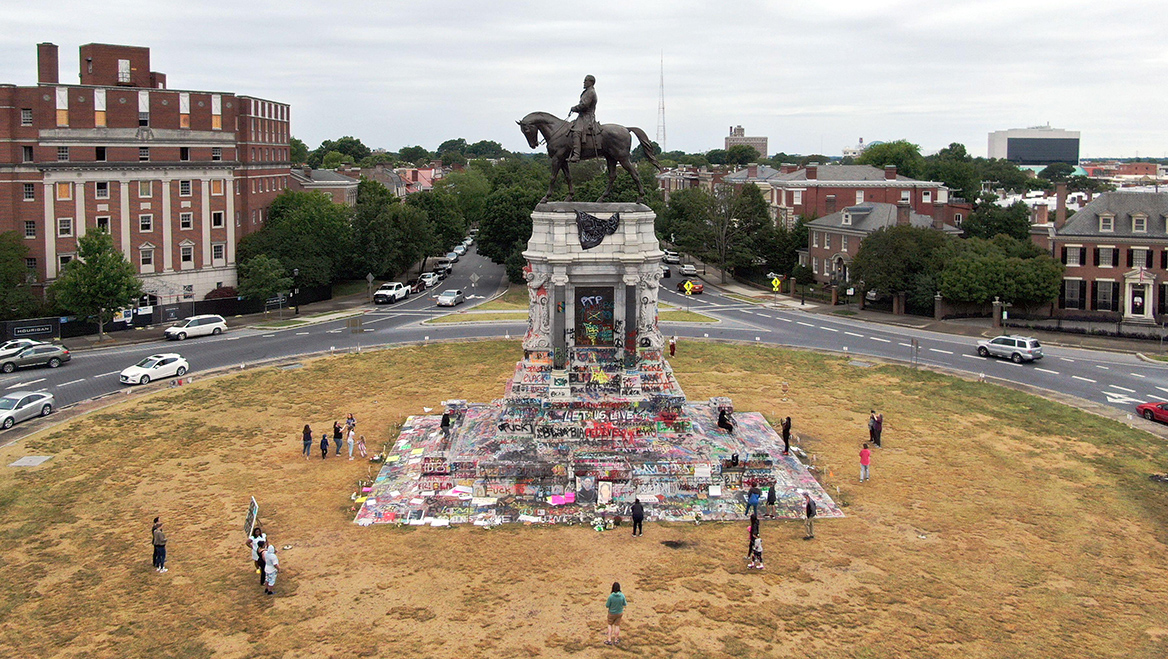
Black Lives Matter protests in 2020 brought into sharp focus how community members in Richmond, Virginia, have struggled with their local history. The statue of Robert E. Lee has since been removed. Photo by Mpi34/Media Punch/Alamy Live News.
There, Knapp studied feedback from 800 residents and found that regardless of where they stood on the issue of monuments to Confederate-era leaders and events, all spoke about common themes of family, pride, trust, and shame. This provided insight to start conversations with a common thread on both sides of the debate: a desire for respect for one's family and ancestors. It also informed plans and proposals to turn Monument Avenue into a more vibrant public space (although little has been done since the city began removing Confederate statues in 2020).
"In cities, a huge issue that gets in the way of things is trust," Knapp says. "For me, [doing the homework] is about knowing where we've been but also trying to really get at what's going on in a community, in terms of trust and social cohesion."
Emily McCoy says that for traditional planning departments to adopt these strategies, they often must be self-aware enough to simply get out of the way. That's why Kinston Teens ran 15 facilitation events, not the Design Workshop. "We use the best data out there and our listening skills to really be the pen for the community to get their vision on property on paper," she says.
Deterred but not defeated
Unfortunately, despite the best of intentions and processes, Kinston has found itself disappointed again. The community hub project depended on a pair of federal grants that the Trump administration appears to have canceled.
However, Suggs says the setback won't be the end of their work. Their strategic planning process included alternatives for more gradual growth timelines and other ways to expand that didn't require grant money.
Trauma-informed planning also means being realistic and upfront about funding challenges and being honest about meeting basic needs.
McCoy says that was by design. Trauma-informed planning also means being realistic and upfront about funding challenges and being honest about meeting basic needs. "If we were a traditional urban design and planning firm, and didn't listen first, we would have come in with these catalytic projects that would have looked really sexy and maybe would have spurred some big economic engine," she says, "but we wanted to listen to the real basic needs [the community has]."
That's why capacity-building and long-term planning are so important, adds Schroeder. This is hard work to do well, and the best solutions often come with meaningful, gradual change. "As trauma has become more common in the general discourse, whether it's public health or it's planning, there's a rush to do more trauma work," she says. "But it's hard to do well, and you want to make sure you're doing it in a way that's comprehensive, sustainable, and long term. It takes a little more buy-in than saying, 'Let's throw a healing park in this neighborhood.'"
Currently, Kinston Teens is expanding its staff and capacity. It recently redesigned an abandoned local church to serve as another neighborhood community center. The group has also started a community garden — another key aspect of the neighborhood hub.
"This has helped shift some of the local perceptions about what community planning is," Suggs says. "It also excites me that the professionals want to learn more about how they can reach more people and be more beneficial."

